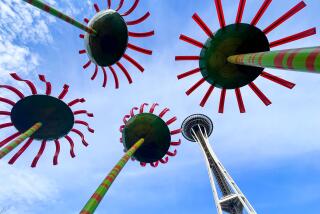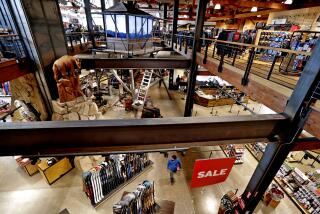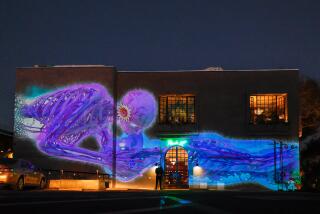REI Gets Stunning--but Practical--New Digs
SEATTLE — Showing off Recreational Equipment Inc.’s stunning new flagship store, a spokesman stresses that every feature--the 30-foot waterfall, seven-story climbing pinnacle, landscaped bike trail, massive stone fireplace--was chosen for its practicality.
How REI.
In a city where glitz is frowned upon, where the parka was pioneered as business attire and even the rockers wear flannel, a cultural icon is going uptown.
The outdoor equipment chain, known to many as just “the co-op,” is as much a part of Seattle’s soul as the deep chord of a ferry’s horn or espresso stains on a raincoat.
For decades, its main store in the Capitol Hill neighborhood has been a place to bring out-of-town guests, as well as the jumping-off point for expeditions from kindergarten hikes to assaults on the K-2 mountain.
The beloved old store was a former auto dealership--a creaky warren of cramped showrooms joined by ramps and oddly spaced stairs, where customers from throughout the world shopped for tents, canoes, skis, outdoor duds, boots, bikes and other gear for “human-powered” recreation.
Visitors often spoke of the building’s distinctive smell: a mix of boot grease, freeze-dried food, oiled wood floors, high-tech plastic, coffee, and creosote from the wooden floor blocks of the old garage.
But most of that will be left behind when REI opens its new store today, despite attempts by the company to “keep the [new] store ‘warm’ and evoke the memory of the old store,” said REI spokesman Christopher Doyle.
Started by a group of mountain climbers in 1938 as a way to order hard-to-find gear, REI has grown to be the nation’s largest member-owned consumer cooperative, with more than 1.4 million members. It has 46 retail outlets nationwide, a worldwide mail-order business and a travel company. Sales last year reached $448 million.
“REI is getting so big, you could see they had to make the move,” said Anthony Myers, who shops for his camping equipment at REI.
Members pay $15 to join and receive a yearly rebate based on how much they buy.
For years after REI moved to Capitol Hill in 1963, it was primarily a backpacking- and climbing-gear store personified by its longtime manager, Jim Whittaker, the first American to climb Mount Everest.
But like other retailers, such as L.L. Bean and Eddie Bauer, REI changed in the late 1970s and 80s to meet the burgeoning demand for a wide range of gear by outdoor enthusiasts, and by those who just wanted to look like they’d been there.
Under Wally Smith, the current president and chief executive officer, REI slowly expanded, mostly in strip malls and college-town storefronts.
The new 99,000-square-foot building is a radical departure.
“This is brand-new for REI,” Doyle said. “We view this as our member clubhouse, and also as a laboratory.”
He wouldn’t say how much the store cost, though published reports have placed it at $30 million. With more than twice the retail space of the old store, it takes up a two-acre block in Seattle’s south Lake Union area, a neighborhood of warehouses and freeway onramps that has begun to revitalize.
Designed by Mithun Partners of Seattle, the store is a soaring mix of wood, glass, steel and concrete designed to suggest a casual mountain lodge, albeit one with a 65-foot, glass-enclosed climbing rock at the front door.
The pinnacle, the tallest free-standing indoor climbing structure in the world, weighs 110 tons and has more than 1,000 artificial holds, enough to accommodate 15 climbers at once. It can challenge both beginners and experts, Doyle says, and will be used by customers to try out products, learn techniques, or just for fun.
The store itself, fundamentally one large room, lets REI offer far more products than the old building--for example, the old store could showcase three dozen bicycles; the new place stocks 350.
Small touches abound at the new store. Ice axes serve as door pulls. Elevator doors are lined by terra-cotta friezes of outdoor scenes. Clocks on the front patio resemble oversize Swiss Army watches and show the times at Everest, Kilimanjaro and other faraway adventure spots.
Outside, the grounds are landscaped with trails to test mountain bikes and hiking boots, a tumbling waterfall that ends in a quiet pool, and 58 different species of Northwest plants.
Despite the studied outdoorsiness, the building is state-of-the-art, designed to be practical and bring in profits, Doyle said. Features include:
* A 250-seat auditorium with big-screen TVs and other multimedia.
* An indoor Global Positioning Satellite system to allow demonstrations of the electronic locating technology.
* Wiring throughout for computers, with terminals to the Internet so customers can find information on outdoor destinations.
* A “rain room” sponsored by Gore-Tex, the maker of waterproof fabric, where customers can check rain gear in showers.
* A sealed “dark room,” where bike lights and headlamps can be tested.
As for the old store, it closes Wednesday and is being sold to a thrift-store chain. To help employees let go of the old landmark, REI management brought in a grief counselor.
And to symbolize the transition, some of the old creosote-soaked floor blocks were taken up and set in the threshold of the new front door.
Some faithful customers came by Monday for one last swing through the old place.
“Almost every time I’ve come in this store, I’ve seen someone I knew,” said Heather Meeds, 35, whose been an REI member since she was 13. “It makes you wonder if that’s going to happen in the big place.”
More to Read
Sign up for The Wild
We’ll help you find the best places to hike, bike and run, as well as the perfect silent spots for meditation and yoga.
You may occasionally receive promotional content from the Los Angeles Times.






